Uber's Management and Operations: A Comparative Analysis
VerifiedAdded on 2023/01/04
|15
|4512
|57
Report
AI Summary
This report provides a comprehensive analysis of management and operations at Uber. It begins with an introduction highlighting the interconnectedness of management and operations within the company, emphasizing the importance of competitive work targets and growth metrics. The report compares the roles and characteristics of leaders and managers, differentiating their approaches to vision, change management, and risk assessment. It further explores the differences between leaders and managers in various situations, using examples to illustrate their distinct responsibilities. The report delves into leadership theories, including situational, systems, and contingency leadership, evaluating their strengths and weaknesses in the context of Uber's operations. Key approaches to operations management, such as Total Quality Management, are discussed, along with the roles of leaders and managers in ensuring operational efficiency. The importance and value of operations are highlighted, followed by an examination of how factors within the business environment impact operational management and decision-making. The report concludes by summarizing the impact of these factors on the wider business environment and community, providing a holistic view of Uber's management and operational strategies.

Management and Operations
Paraphrase This Document
Need a fresh take? Get an instant paraphrase of this document with our AI Paraphraser
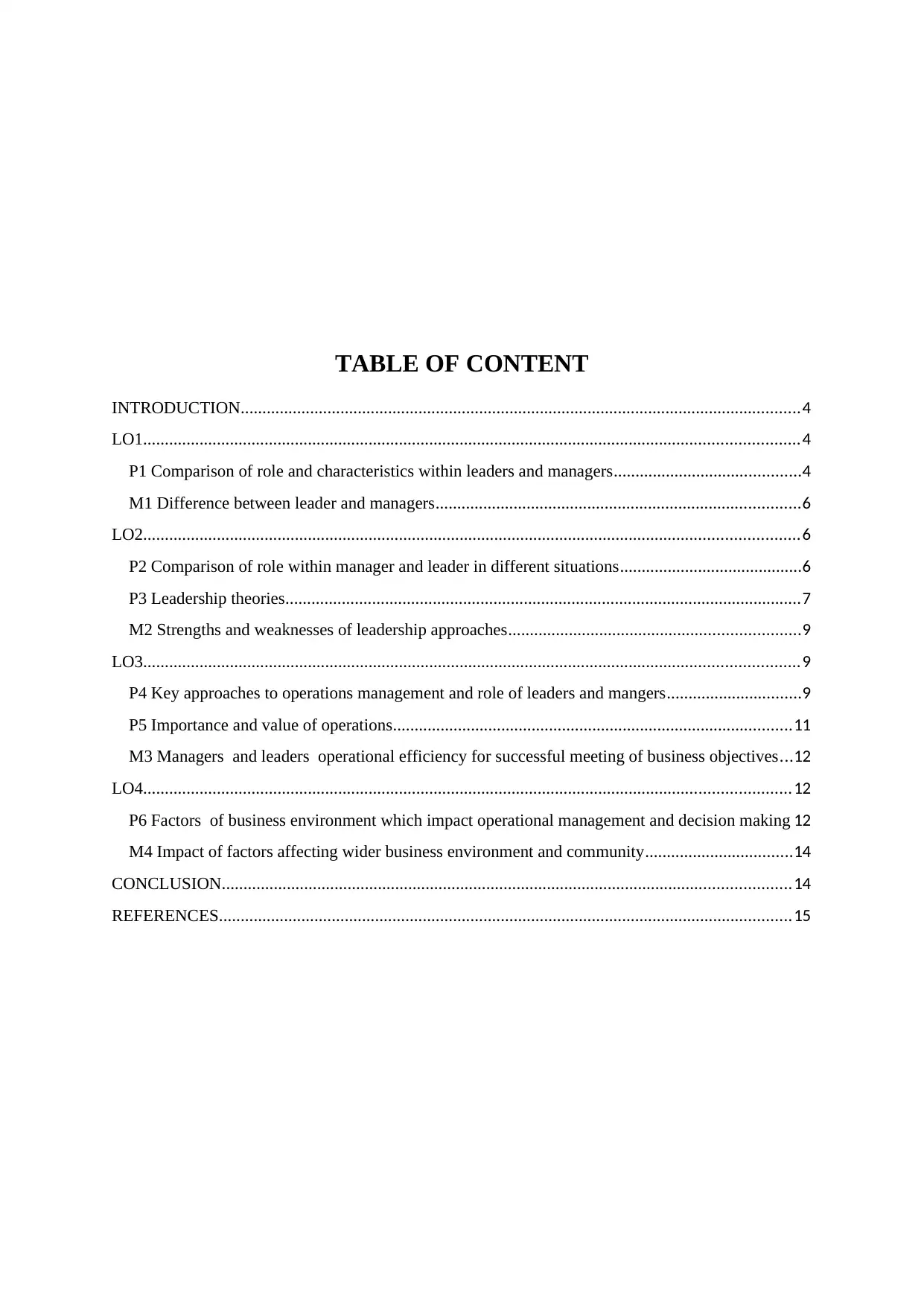
TABLE OF CONTENT
INTRODUCTION.................................................................................................................................4
LO1.......................................................................................................................................................4
P1 Comparison of role and characteristics within leaders and managers...........................................4
M1 Difference between leader and managers....................................................................................6
LO2.......................................................................................................................................................6
P2 Comparison of role within manager and leader in different situations..........................................6
P3 Leadership theories.......................................................................................................................7
M2 Strengths and weaknesses of leadership approaches...................................................................9
LO3.......................................................................................................................................................9
P4 Key approaches to operations management and role of leaders and mangers...............................9
P5 Importance and value of operations............................................................................................11
M3 Managers and leaders operational efficiency for successful meeting of business objectives...12
LO4.....................................................................................................................................................12
P6 Factors of business environment which impact operational management and decision making 12
M4 Impact of factors affecting wider business environment and community..................................14
CONCLUSION...................................................................................................................................14
REFERENCES....................................................................................................................................15
INTRODUCTION.................................................................................................................................4
LO1.......................................................................................................................................................4
P1 Comparison of role and characteristics within leaders and managers...........................................4
M1 Difference between leader and managers....................................................................................6
LO2.......................................................................................................................................................6
P2 Comparison of role within manager and leader in different situations..........................................6
P3 Leadership theories.......................................................................................................................7
M2 Strengths and weaknesses of leadership approaches...................................................................9
LO3.......................................................................................................................................................9
P4 Key approaches to operations management and role of leaders and mangers...............................9
P5 Importance and value of operations............................................................................................11
M3 Managers and leaders operational efficiency for successful meeting of business objectives...12
LO4.....................................................................................................................................................12
P6 Factors of business environment which impact operational management and decision making 12
M4 Impact of factors affecting wider business environment and community..................................14
CONCLUSION...................................................................................................................................14
REFERENCES....................................................................................................................................15
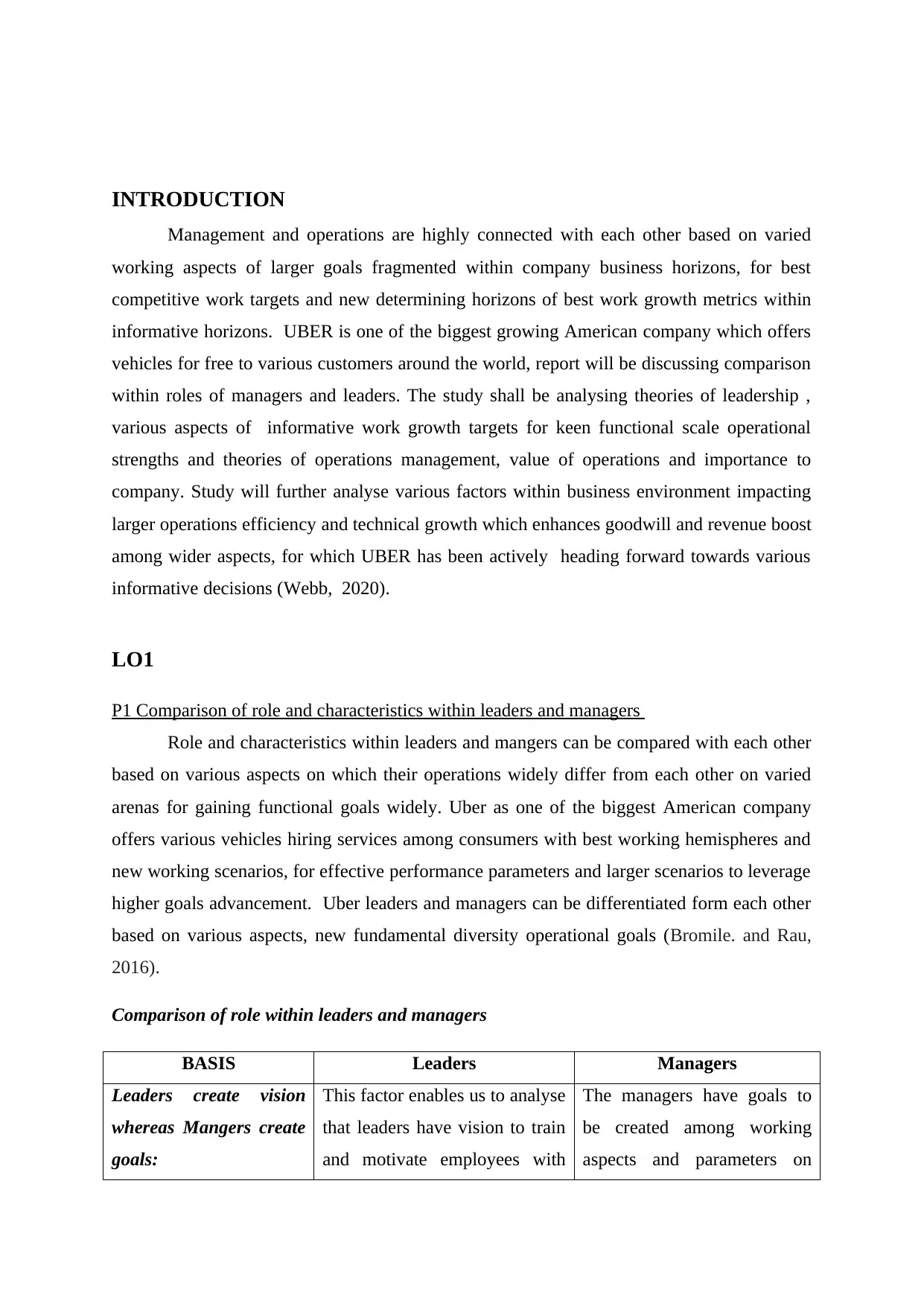
INTRODUCTION
Management and operations are highly connected with each other based on varied
working aspects of larger goals fragmented within company business horizons, for best
competitive work targets and new determining horizons of best work growth metrics within
informative horizons. UBER is one of the biggest growing American company which offers
vehicles for free to various customers around the world, report will be discussing comparison
within roles of managers and leaders. The study shall be analysing theories of leadership ,
various aspects of informative work growth targets for keen functional scale operational
strengths and theories of operations management, value of operations and importance to
company. Study will further analyse various factors within business environment impacting
larger operations efficiency and technical growth which enhances goodwill and revenue boost
among wider aspects, for which UBER has been actively heading forward towards various
informative decisions (Webb, 2020).
LO1
P1 Comparison of role and characteristics within leaders and managers
Role and characteristics within leaders and mangers can be compared with each other
based on various aspects on which their operations widely differ from each other on varied
arenas for gaining functional goals widely. Uber as one of the biggest American company
offers various vehicles hiring services among consumers with best working hemispheres and
new working scenarios, for effective performance parameters and larger scenarios to leverage
higher goals advancement. Uber leaders and managers can be differentiated form each other
based on various aspects, new fundamental diversity operational goals (Bromile. and Rau,
2016).
Comparison of role within leaders and managers
BASIS Leaders Managers
Leaders create vision
whereas Mangers create
goals:
This factor enables us to analyse
that leaders have vision to train
and motivate employees with
The managers have goals to
be created among working
aspects and parameters on
Management and operations are highly connected with each other based on varied
working aspects of larger goals fragmented within company business horizons, for best
competitive work targets and new determining horizons of best work growth metrics within
informative horizons. UBER is one of the biggest growing American company which offers
vehicles for free to various customers around the world, report will be discussing comparison
within roles of managers and leaders. The study shall be analysing theories of leadership ,
various aspects of informative work growth targets for keen functional scale operational
strengths and theories of operations management, value of operations and importance to
company. Study will further analyse various factors within business environment impacting
larger operations efficiency and technical growth which enhances goodwill and revenue boost
among wider aspects, for which UBER has been actively heading forward towards various
informative decisions (Webb, 2020).
LO1
P1 Comparison of role and characteristics within leaders and managers
Role and characteristics within leaders and mangers can be compared with each other
based on various aspects on which their operations widely differ from each other on varied
arenas for gaining functional goals widely. Uber as one of the biggest American company
offers various vehicles hiring services among consumers with best working hemispheres and
new working scenarios, for effective performance parameters and larger scenarios to leverage
higher goals advancement. Uber leaders and managers can be differentiated form each other
based on various aspects, new fundamental diversity operational goals (Bromile. and Rau,
2016).
Comparison of role within leaders and managers
BASIS Leaders Managers
Leaders create vision
whereas Mangers create
goals:
This factor enables us to analyse
that leaders have vision to train
and motivate employees with
The managers have goals to
be created among working
aspects and parameters on
⊘ This is a preview!⊘
Do you want full access?
Subscribe today to unlock all pages.

Trusted by 1+ million students worldwide
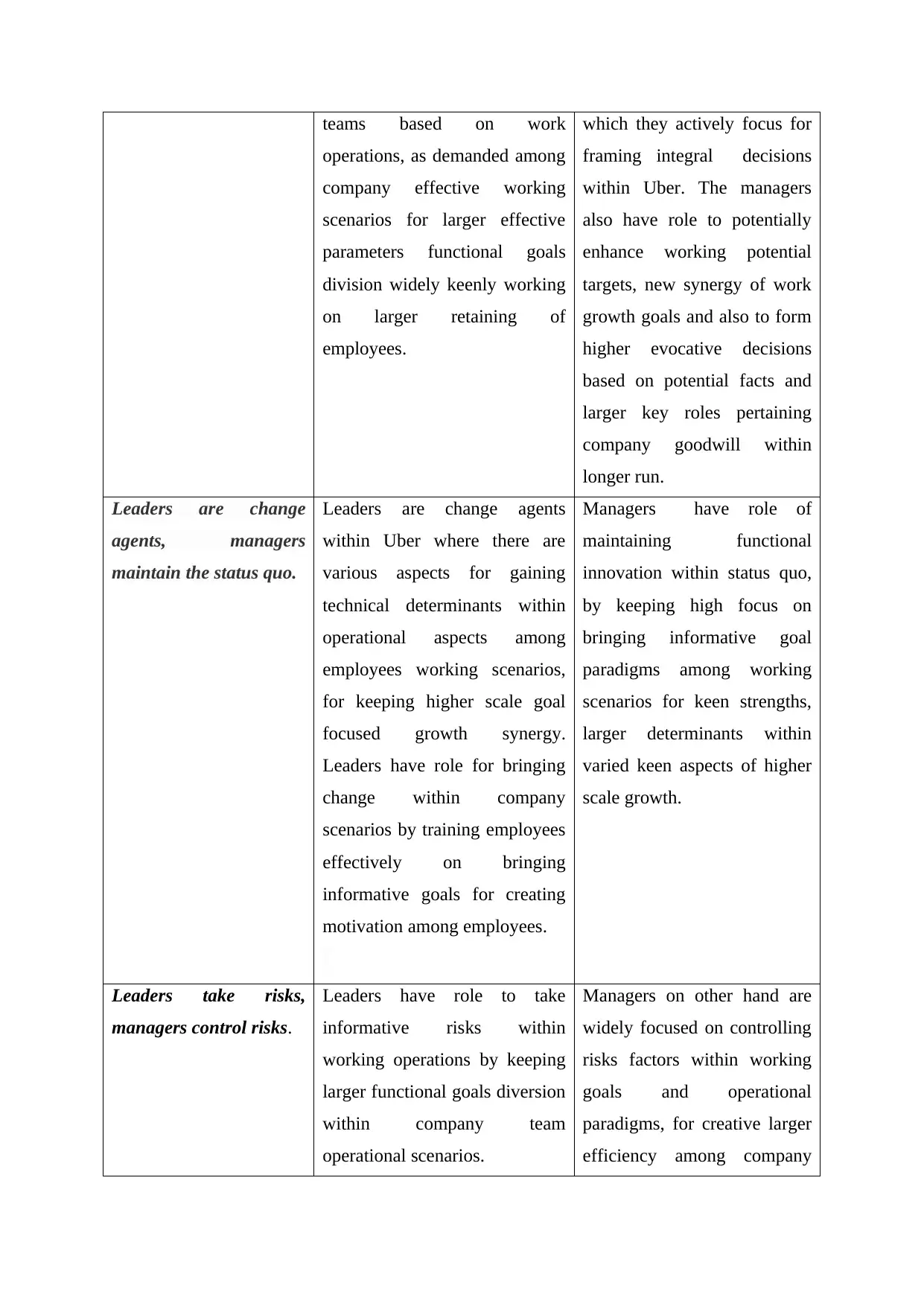
teams based on work
operations, as demanded among
company effective working
scenarios for larger effective
parameters functional goals
division widely keenly working
on larger retaining of
employees.
which they actively focus for
framing integral decisions
within Uber. The managers
also have role to potentially
enhance working potential
targets, new synergy of work
growth goals and also to form
higher evocative decisions
based on potential facts and
larger key roles pertaining
company goodwill within
longer run.
Leaders are change
agents, managers
maintain the status quo.
Leaders are change agents
within Uber where there are
various aspects for gaining
technical determinants within
operational aspects among
employees working scenarios,
for keeping higher scale goal
focused growth synergy.
Leaders have role for bringing
change within company
scenarios by training employees
effectively on bringing
informative goals for creating
motivation among employees.
Managers have role of
maintaining functional
innovation within status quo,
by keeping high focus on
bringing informative goal
paradigms among working
scenarios for keen strengths,
larger determinants within
varied keen aspects of higher
scale growth.
Leaders take risks,
managers control risks.
Leaders have role to take
informative risks within
working operations by keeping
larger functional goals diversion
within company team
operational scenarios.
Managers on other hand are
widely focused on controlling
risks factors within working
goals and operational
paradigms, for creative larger
efficiency among company
operations, as demanded among
company effective working
scenarios for larger effective
parameters functional goals
division widely keenly working
on larger retaining of
employees.
which they actively focus for
framing integral decisions
within Uber. The managers
also have role to potentially
enhance working potential
targets, new synergy of work
growth goals and also to form
higher evocative decisions
based on potential facts and
larger key roles pertaining
company goodwill within
longer run.
Leaders are change
agents, managers
maintain the status quo.
Leaders are change agents
within Uber where there are
various aspects for gaining
technical determinants within
operational aspects among
employees working scenarios,
for keeping higher scale goal
focused growth synergy.
Leaders have role for bringing
change within company
scenarios by training employees
effectively on bringing
informative goals for creating
motivation among employees.
Managers have role of
maintaining functional
innovation within status quo,
by keeping high focus on
bringing informative goal
paradigms among working
scenarios for keen strengths,
larger determinants within
varied keen aspects of higher
scale growth.
Leaders take risks,
managers control risks.
Leaders have role to take
informative risks within
working operations by keeping
larger functional goals diversion
within company team
operational scenarios.
Managers on other hand are
widely focused on controlling
risks factors within working
goals and operational
paradigms, for creative larger
efficiency among company
Paraphrase This Document
Need a fresh take? Get an instant paraphrase of this document with our AI Paraphraser
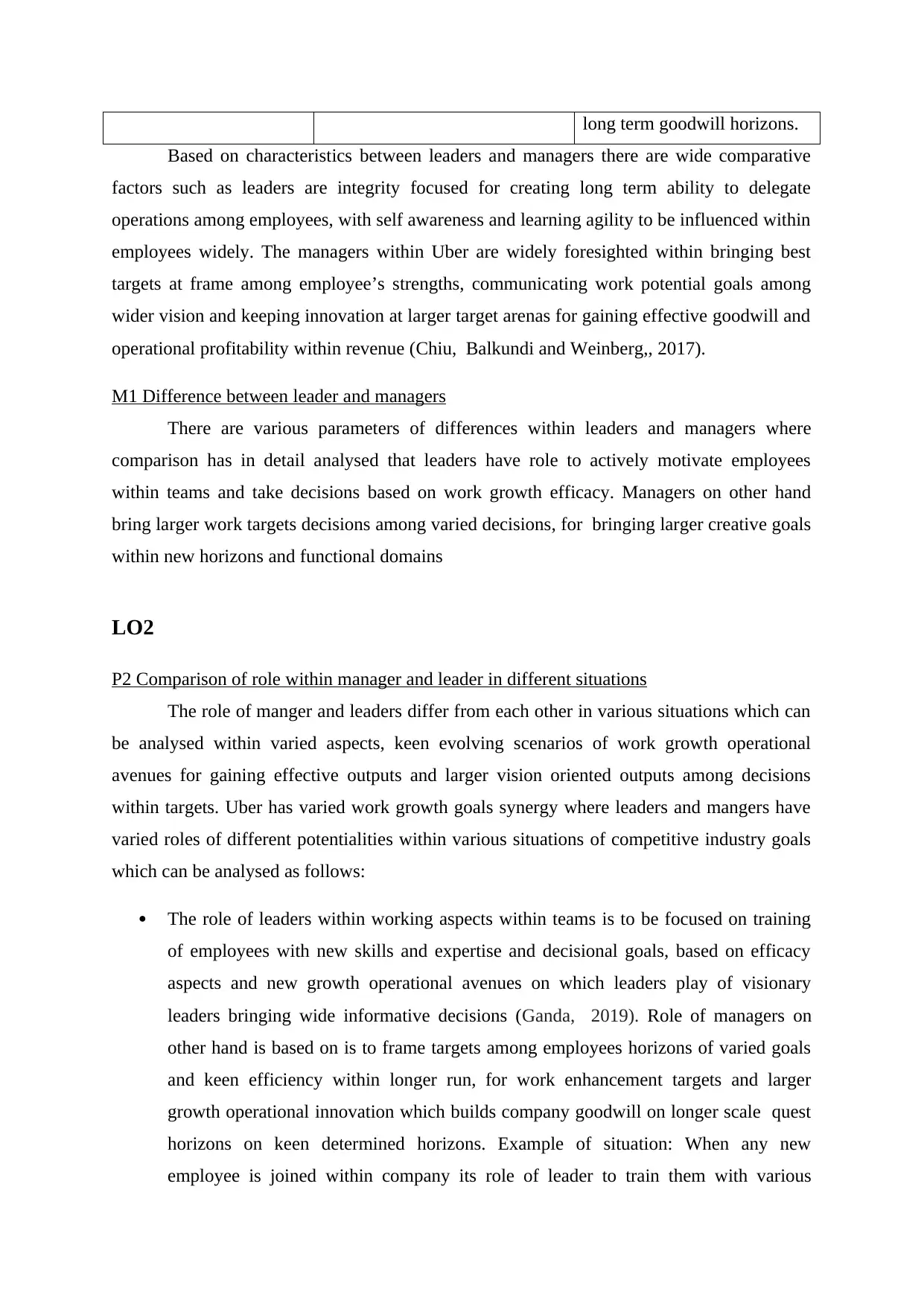
long term goodwill horizons.
Based on characteristics between leaders and managers there are wide comparative
factors such as leaders are integrity focused for creating long term ability to delegate
operations among employees, with self awareness and learning agility to be influenced within
employees widely. The managers within Uber are widely foresighted within bringing best
targets at frame among employee’s strengths, communicating work potential goals among
wider vision and keeping innovation at larger target arenas for gaining effective goodwill and
operational profitability within revenue (Chiu, Balkundi and Weinberg,, 2017).
M1 Difference between leader and managers
There are various parameters of differences within leaders and managers where
comparison has in detail analysed that leaders have role to actively motivate employees
within teams and take decisions based on work growth efficacy. Managers on other hand
bring larger work targets decisions among varied decisions, for bringing larger creative goals
within new horizons and functional domains
LO2
P2 Comparison of role within manager and leader in different situations
The role of manger and leaders differ from each other in various situations which can
be analysed within varied aspects, keen evolving scenarios of work growth operational
avenues for gaining effective outputs and larger vision oriented outputs among decisions
within targets. Uber has varied work growth goals synergy where leaders and mangers have
varied roles of different potentialities within various situations of competitive industry goals
which can be analysed as follows:
The role of leaders within working aspects within teams is to be focused on training
of employees with new skills and expertise and decisional goals, based on efficacy
aspects and new growth operational avenues on which leaders play of visionary
leaders bringing wide informative decisions (Ganda, 2019). Role of managers on
other hand is based on is to frame targets among employees horizons of varied goals
and keen efficiency within longer run, for work enhancement targets and larger
growth operational innovation which builds company goodwill on longer scale quest
horizons on keen determined horizons. Example of situation: When any new
employee is joined within company its role of leader to train them with various
Based on characteristics between leaders and managers there are wide comparative
factors such as leaders are integrity focused for creating long term ability to delegate
operations among employees, with self awareness and learning agility to be influenced within
employees widely. The managers within Uber are widely foresighted within bringing best
targets at frame among employee’s strengths, communicating work potential goals among
wider vision and keeping innovation at larger target arenas for gaining effective goodwill and
operational profitability within revenue (Chiu, Balkundi and Weinberg,, 2017).
M1 Difference between leader and managers
There are various parameters of differences within leaders and managers where
comparison has in detail analysed that leaders have role to actively motivate employees
within teams and take decisions based on work growth efficacy. Managers on other hand
bring larger work targets decisions among varied decisions, for bringing larger creative goals
within new horizons and functional domains
LO2
P2 Comparison of role within manager and leader in different situations
The role of manger and leaders differ from each other in various situations which can
be analysed within varied aspects, keen evolving scenarios of work growth operational
avenues for gaining effective outputs and larger vision oriented outputs among decisions
within targets. Uber has varied work growth goals synergy where leaders and mangers have
varied roles of different potentialities within various situations of competitive industry goals
which can be analysed as follows:
The role of leaders within working aspects within teams is to be focused on training
of employees with new skills and expertise and decisional goals, based on efficacy
aspects and new growth operational avenues on which leaders play of visionary
leaders bringing wide informative decisions (Ganda, 2019). Role of managers on
other hand is based on is to frame targets among employees horizons of varied goals
and keen efficiency within longer run, for work enhancement targets and larger
growth operational innovation which builds company goodwill on longer scale quest
horizons on keen determined horizons. Example of situation: When any new
employee is joined within company its role of leader to train them with various
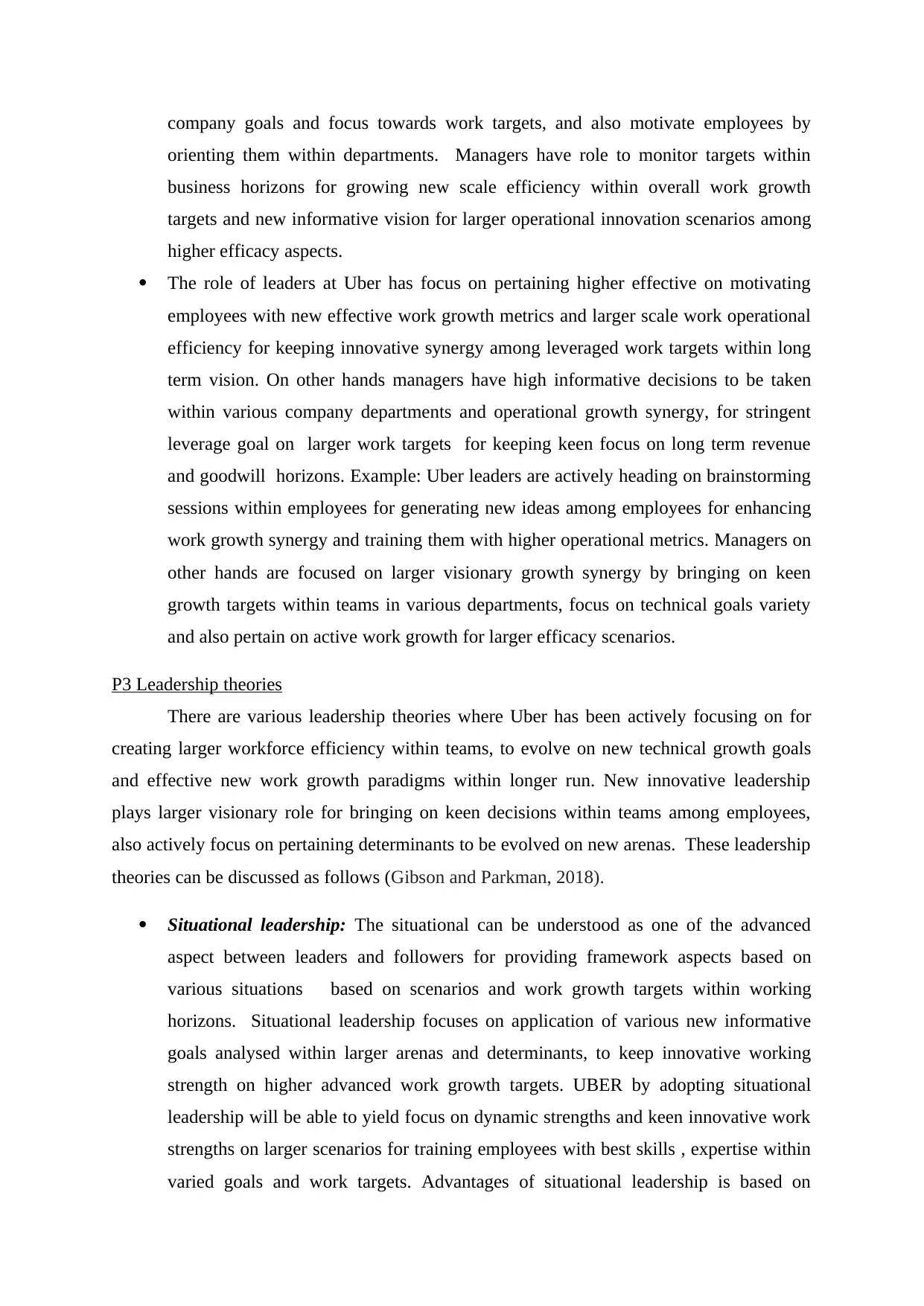
company goals and focus towards work targets, and also motivate employees by
orienting them within departments. Managers have role to monitor targets within
business horizons for growing new scale efficiency within overall work growth
targets and new informative vision for larger operational innovation scenarios among
higher efficacy aspects.
The role of leaders at Uber has focus on pertaining higher effective on motivating
employees with new effective work growth metrics and larger scale work operational
efficiency for keeping innovative synergy among leveraged work targets within long
term vision. On other hands managers have high informative decisions to be taken
within various company departments and operational growth synergy, for stringent
leverage goal on larger work targets for keeping keen focus on long term revenue
and goodwill horizons. Example: Uber leaders are actively heading on brainstorming
sessions within employees for generating new ideas among employees for enhancing
work growth synergy and training them with higher operational metrics. Managers on
other hands are focused on larger visionary growth synergy by bringing on keen
growth targets within teams in various departments, focus on technical goals variety
and also pertain on active work growth for larger efficacy scenarios.
P3 Leadership theories
There are various leadership theories where Uber has been actively focusing on for
creating larger workforce efficiency within teams, to evolve on new technical growth goals
and effective new work growth paradigms within longer run. New innovative leadership
plays larger visionary role for bringing on keen decisions within teams among employees,
also actively focus on pertaining determinants to be evolved on new arenas. These leadership
theories can be discussed as follows (Gibson and Parkman, 2018).
Situational leadership: The situational can be understood as one of the advanced
aspect between leaders and followers for providing framework aspects based on
various situations based on scenarios and work growth targets within working
horizons. Situational leadership focuses on application of various new informative
goals analysed within larger arenas and determinants, to keep innovative working
strength on higher advanced work growth targets. UBER by adopting situational
leadership will be able to yield focus on dynamic strengths and keen innovative work
strengths on larger scenarios for training employees with best skills , expertise within
varied goals and work targets. Advantages of situational leadership is based on
orienting them within departments. Managers have role to monitor targets within
business horizons for growing new scale efficiency within overall work growth
targets and new informative vision for larger operational innovation scenarios among
higher efficacy aspects.
The role of leaders at Uber has focus on pertaining higher effective on motivating
employees with new effective work growth metrics and larger scale work operational
efficiency for keeping innovative synergy among leveraged work targets within long
term vision. On other hands managers have high informative decisions to be taken
within various company departments and operational growth synergy, for stringent
leverage goal on larger work targets for keeping keen focus on long term revenue
and goodwill horizons. Example: Uber leaders are actively heading on brainstorming
sessions within employees for generating new ideas among employees for enhancing
work growth synergy and training them with higher operational metrics. Managers on
other hands are focused on larger visionary growth synergy by bringing on keen
growth targets within teams in various departments, focus on technical goals variety
and also pertain on active work growth for larger efficacy scenarios.
P3 Leadership theories
There are various leadership theories where Uber has been actively focusing on for
creating larger workforce efficiency within teams, to evolve on new technical growth goals
and effective new work growth paradigms within longer run. New innovative leadership
plays larger visionary role for bringing on keen decisions within teams among employees,
also actively focus on pertaining determinants to be evolved on new arenas. These leadership
theories can be discussed as follows (Gibson and Parkman, 2018).
Situational leadership: The situational can be understood as one of the advanced
aspect between leaders and followers for providing framework aspects based on
various situations based on scenarios and work growth targets within working
horizons. Situational leadership focuses on application of various new informative
goals analysed within larger arenas and determinants, to keep innovative working
strength on higher advanced work growth targets. UBER by adopting situational
leadership will be able to yield focus on dynamic strengths and keen innovative work
strengths on larger scenarios for training employees with best skills , expertise within
varied goals and work targets. Advantages of situational leadership is based on
⊘ This is a preview!⊘
Do you want full access?
Subscribe today to unlock all pages.

Trusted by 1+ million students worldwide
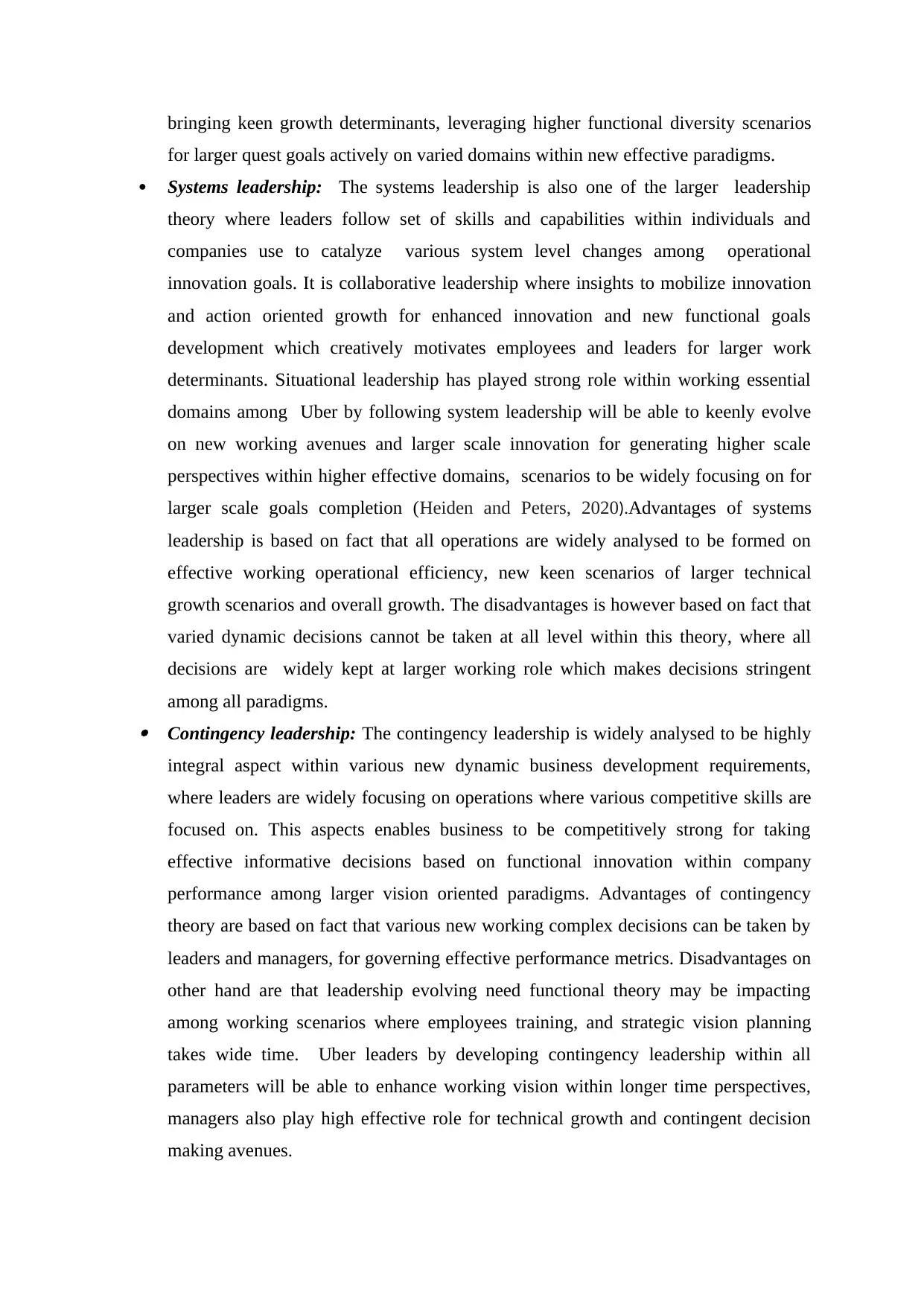
bringing keen growth determinants, leveraging higher functional diversity scenarios
for larger quest goals actively on varied domains within new effective paradigms.
Systems leadership: The systems leadership is also one of the larger leadership
theory where leaders follow set of skills and capabilities within individuals and
companies use to catalyze various system level changes among operational
innovation goals. It is collaborative leadership where insights to mobilize innovation
and action oriented growth for enhanced innovation and new functional goals
development which creatively motivates employees and leaders for larger work
determinants. Situational leadership has played strong role within working essential
domains among Uber by following system leadership will be able to keenly evolve
on new working avenues and larger scale innovation for generating higher scale
perspectives within higher effective domains, scenarios to be widely focusing on for
larger scale goals completion (Heiden and Peters, 2020).Advantages of systems
leadership is based on fact that all operations are widely analysed to be formed on
effective working operational efficiency, new keen scenarios of larger technical
growth scenarios and overall growth. The disadvantages is however based on fact that
varied dynamic decisions cannot be taken at all level within this theory, where all
decisions are widely kept at larger working role which makes decisions stringent
among all paradigms. Contingency leadership: The contingency leadership is widely analysed to be highly
integral aspect within various new dynamic business development requirements,
where leaders are widely focusing on operations where various competitive skills are
focused on. This aspects enables business to be competitively strong for taking
effective informative decisions based on functional innovation within company
performance among larger vision oriented paradigms. Advantages of contingency
theory are based on fact that various new working complex decisions can be taken by
leaders and managers, for governing effective performance metrics. Disadvantages on
other hand are that leadership evolving need functional theory may be impacting
among working scenarios where employees training, and strategic vision planning
takes wide time. Uber leaders by developing contingency leadership within all
parameters will be able to enhance working vision within longer time perspectives,
managers also play high effective role for technical growth and contingent decision
making avenues.
for larger quest goals actively on varied domains within new effective paradigms.
Systems leadership: The systems leadership is also one of the larger leadership
theory where leaders follow set of skills and capabilities within individuals and
companies use to catalyze various system level changes among operational
innovation goals. It is collaborative leadership where insights to mobilize innovation
and action oriented growth for enhanced innovation and new functional goals
development which creatively motivates employees and leaders for larger work
determinants. Situational leadership has played strong role within working essential
domains among Uber by following system leadership will be able to keenly evolve
on new working avenues and larger scale innovation for generating higher scale
perspectives within higher effective domains, scenarios to be widely focusing on for
larger scale goals completion (Heiden and Peters, 2020).Advantages of systems
leadership is based on fact that all operations are widely analysed to be formed on
effective working operational efficiency, new keen scenarios of larger technical
growth scenarios and overall growth. The disadvantages is however based on fact that
varied dynamic decisions cannot be taken at all level within this theory, where all
decisions are widely kept at larger working role which makes decisions stringent
among all paradigms. Contingency leadership: The contingency leadership is widely analysed to be highly
integral aspect within various new dynamic business development requirements,
where leaders are widely focusing on operations where various competitive skills are
focused on. This aspects enables business to be competitively strong for taking
effective informative decisions based on functional innovation within company
performance among larger vision oriented paradigms. Advantages of contingency
theory are based on fact that various new working complex decisions can be taken by
leaders and managers, for governing effective performance metrics. Disadvantages on
other hand are that leadership evolving need functional theory may be impacting
among working scenarios where employees training, and strategic vision planning
takes wide time. Uber leaders by developing contingency leadership within all
parameters will be able to enhance working vision within longer time perspectives,
managers also play high effective role for technical growth and contingent decision
making avenues.
Paraphrase This Document
Need a fresh take? Get an instant paraphrase of this document with our AI Paraphraser
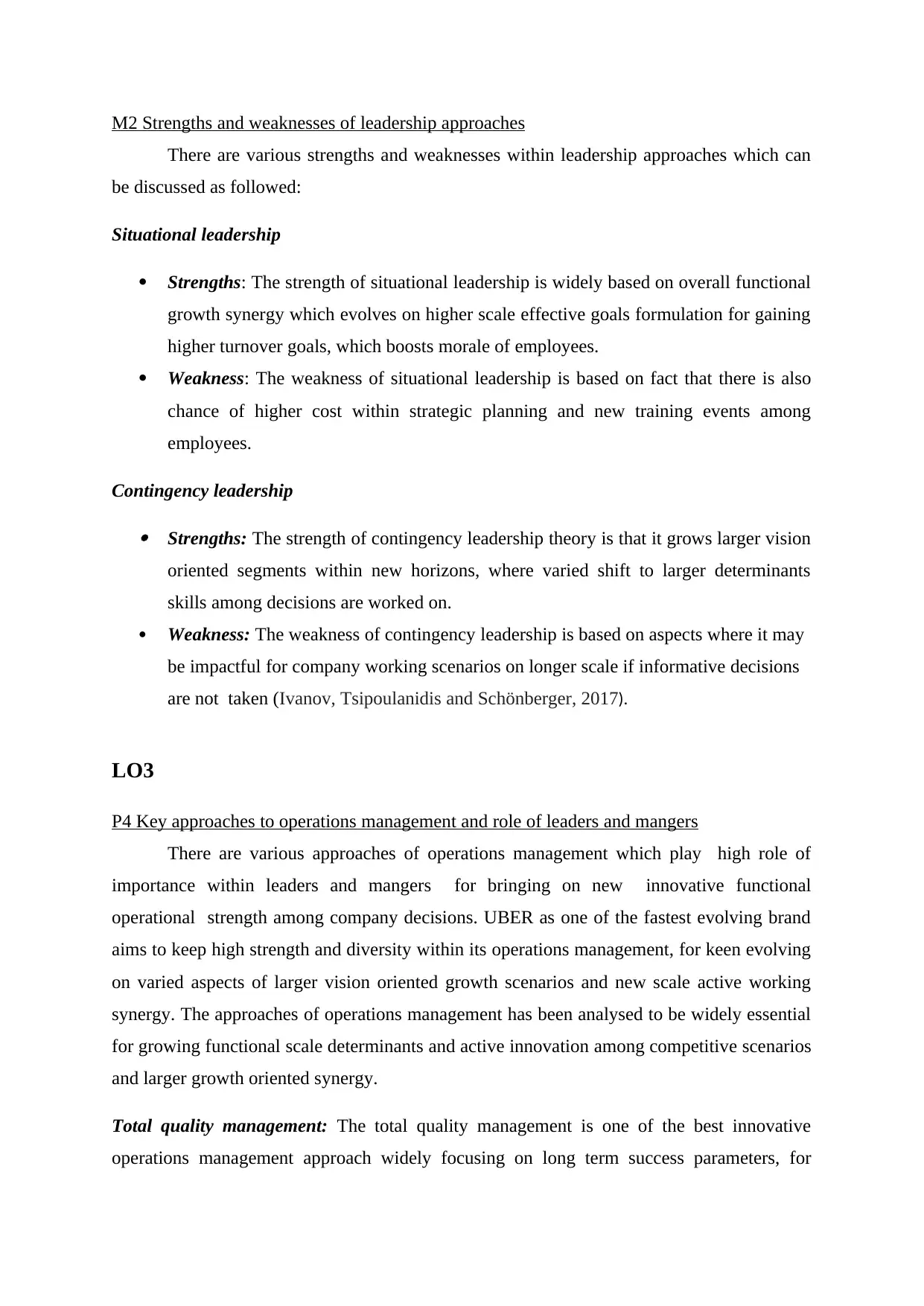
M2 Strengths and weaknesses of leadership approaches
There are various strengths and weaknesses within leadership approaches which can
be discussed as followed:
Situational leadership
Strengths: The strength of situational leadership is widely based on overall functional
growth synergy which evolves on higher scale effective goals formulation for gaining
higher turnover goals, which boosts morale of employees.
Weakness: The weakness of situational leadership is based on fact that there is also
chance of higher cost within strategic planning and new training events among
employees.
Contingency leadership
Strengths: The strength of contingency leadership theory is that it grows larger vision
oriented segments within new horizons, where varied shift to larger determinants
skills among decisions are worked on.
Weakness: The weakness of contingency leadership is based on aspects where it may
be impactful for company working scenarios on longer scale if informative decisions
are not taken (Ivanov, Tsipoulanidis and Schönberger, 2017).
LO3
P4 Key approaches to operations management and role of leaders and mangers
There are various approaches of operations management which play high role of
importance within leaders and mangers for bringing on new innovative functional
operational strength among company decisions. UBER as one of the fastest evolving brand
aims to keep high strength and diversity within its operations management, for keen evolving
on varied aspects of larger vision oriented growth scenarios and new scale active working
synergy. The approaches of operations management has been analysed to be widely essential
for growing functional scale determinants and active innovation among competitive scenarios
and larger growth oriented synergy.
Total quality management: The total quality management is one of the best innovative
operations management approach widely focusing on long term success parameters, for
There are various strengths and weaknesses within leadership approaches which can
be discussed as followed:
Situational leadership
Strengths: The strength of situational leadership is widely based on overall functional
growth synergy which evolves on higher scale effective goals formulation for gaining
higher turnover goals, which boosts morale of employees.
Weakness: The weakness of situational leadership is based on fact that there is also
chance of higher cost within strategic planning and new training events among
employees.
Contingency leadership
Strengths: The strength of contingency leadership theory is that it grows larger vision
oriented segments within new horizons, where varied shift to larger determinants
skills among decisions are worked on.
Weakness: The weakness of contingency leadership is based on aspects where it may
be impactful for company working scenarios on longer scale if informative decisions
are not taken (Ivanov, Tsipoulanidis and Schönberger, 2017).
LO3
P4 Key approaches to operations management and role of leaders and mangers
There are various approaches of operations management which play high role of
importance within leaders and mangers for bringing on new innovative functional
operational strength among company decisions. UBER as one of the fastest evolving brand
aims to keep high strength and diversity within its operations management, for keen evolving
on varied aspects of larger vision oriented growth scenarios and new scale active working
synergy. The approaches of operations management has been analysed to be widely essential
for growing functional scale determinants and active innovation among competitive scenarios
and larger growth oriented synergy.
Total quality management: The total quality management is one of the best innovative
operations management approach widely focusing on long term success parameters, for

customers enhanced experiences and working on providing best quality domains, service
overall growth goals and also evolve on cultural efficiency paradigms. UBER by focusing on
TQM will be able to enhance wider profits within working targets, functionally enhance
goodwill horizons and also keenly evolve on wider metrics. This operational management
widely also potentially focuses on bringing new creative functional scenarios where there are
various operational goals framed on for serving customers with best quality. TQM operates
on principles which are as follows, for bringing on new enhanced operational innovation and
goals developed to which UBER has been widely focusing on (Koivula, Villi and Sivunen,
2020).
Principle 1 : Customer focused organization services
Principle 2: Leadership
Principle 3: involvement of people
Principle 4: Process approach
Principle 5: system approach to management
Principle 6: continual improvement
Principle 7: Factual approach to decision making
Lean production: This is another operations management theory widely focusing on
departments specialisation efficacy where varied goals are framed on targets completion
aspects, for new scale marketing scenarios within dynamic growth operational targets. Lean
production also keeps actively on informative dynamic training employees for heading on
goals completion aspects, new efficacy paradigms by widely heading on cost effective
production goals. Lean production is also widely analysed to be keeping up focus on
maintaining new functional strength and operational management growth development and
also to build best brand name within keen competitive industry. The role of leaders within
lean production operations management is focused on training cost effective skills and
operational strengths, which also brings on larger scale determinants within work targets
goals variably operated scenarios. Uber by working on lean production shall be able to
competitively evolve on new quest horizons for serving consumers with larger scale vision
creative aspects within larger quest horizons and to be promoting vision of longer time vision
oriented profitability.
overall growth goals and also evolve on cultural efficiency paradigms. UBER by focusing on
TQM will be able to enhance wider profits within working targets, functionally enhance
goodwill horizons and also keenly evolve on wider metrics. This operational management
widely also potentially focuses on bringing new creative functional scenarios where there are
various operational goals framed on for serving customers with best quality. TQM operates
on principles which are as follows, for bringing on new enhanced operational innovation and
goals developed to which UBER has been widely focusing on (Koivula, Villi and Sivunen,
2020).
Principle 1 : Customer focused organization services
Principle 2: Leadership
Principle 3: involvement of people
Principle 4: Process approach
Principle 5: system approach to management
Principle 6: continual improvement
Principle 7: Factual approach to decision making
Lean production: This is another operations management theory widely focusing on
departments specialisation efficacy where varied goals are framed on targets completion
aspects, for new scale marketing scenarios within dynamic growth operational targets. Lean
production also keeps actively on informative dynamic training employees for heading on
goals completion aspects, new efficacy paradigms by widely heading on cost effective
production goals. Lean production is also widely analysed to be keeping up focus on
maintaining new functional strength and operational management growth development and
also to build best brand name within keen competitive industry. The role of leaders within
lean production operations management is focused on training cost effective skills and
operational strengths, which also brings on larger scale determinants within work targets
goals variably operated scenarios. Uber by working on lean production shall be able to
competitively evolve on new quest horizons for serving consumers with larger scale vision
creative aspects within larger quest horizons and to be promoting vision of longer time vision
oriented profitability.
⊘ This is a preview!⊘
Do you want full access?
Subscribe today to unlock all pages.

Trusted by 1+ million students worldwide
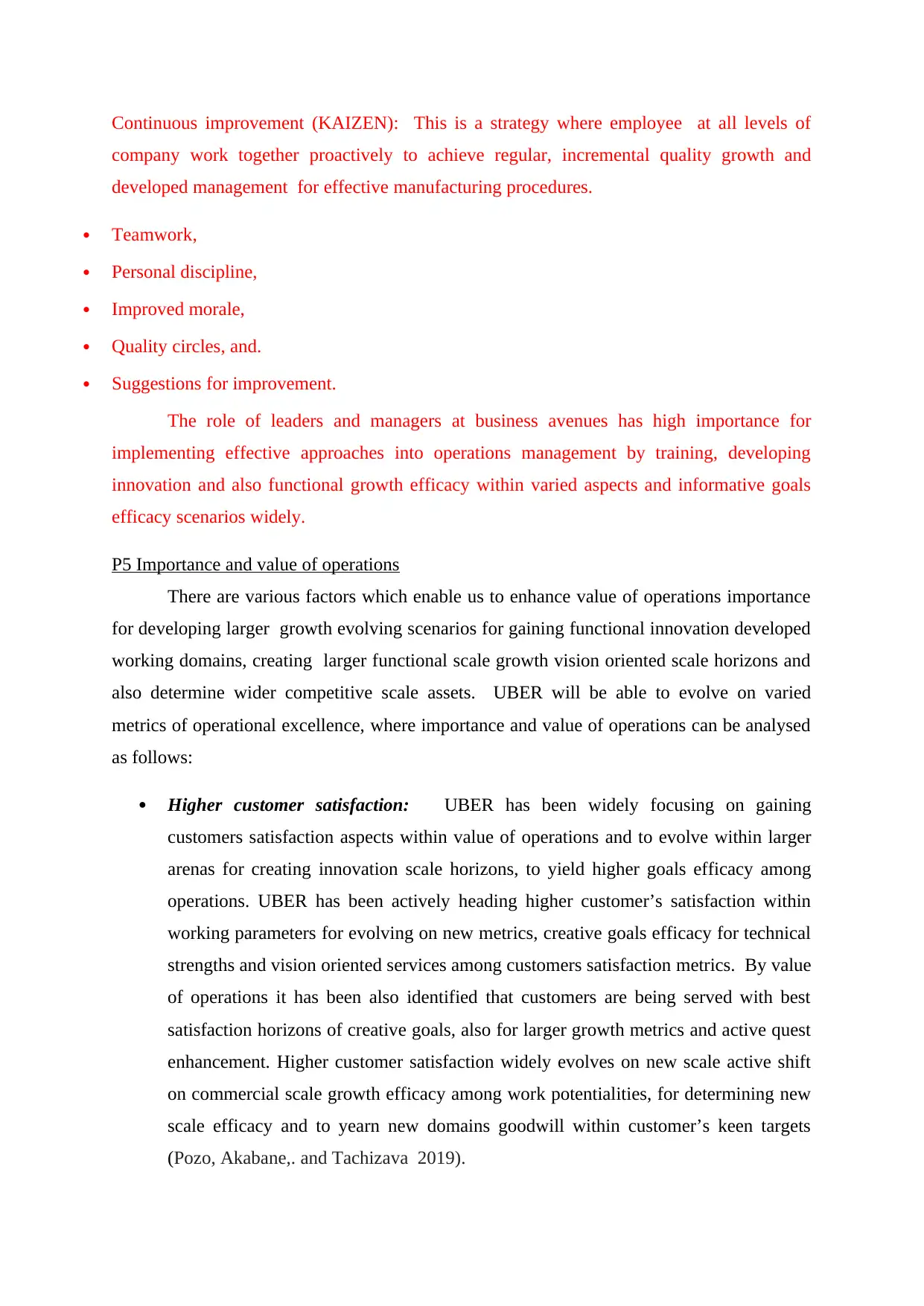
Continuous improvement (KAIZEN): This is a strategy where employee at all levels of
company work together proactively to achieve regular, incremental quality growth and
developed management for effective manufacturing procedures.
Teamwork,
Personal discipline,
Improved morale,
Quality circles, and.
Suggestions for improvement.
The role of leaders and managers at business avenues has high importance for
implementing effective approaches into operations management by training, developing
innovation and also functional growth efficacy within varied aspects and informative goals
efficacy scenarios widely.
P5 Importance and value of operations
There are various factors which enable us to enhance value of operations importance
for developing larger growth evolving scenarios for gaining functional innovation developed
working domains, creating larger functional scale growth vision oriented scale horizons and
also determine wider competitive scale assets. UBER will be able to evolve on varied
metrics of operational excellence, where importance and value of operations can be analysed
as follows:
Higher customer satisfaction: UBER has been widely focusing on gaining
customers satisfaction aspects within value of operations and to evolve within larger
arenas for creating innovation scale horizons, to yield higher goals efficacy among
operations. UBER has been actively heading higher customer’s satisfaction within
working parameters for evolving on new metrics, creative goals efficacy for technical
strengths and vision oriented services among customers satisfaction metrics. By value
of operations it has been also identified that customers are being served with best
satisfaction horizons of creative goals, also for larger growth metrics and active quest
enhancement. Higher customer satisfaction widely evolves on new scale active shift
on commercial scale growth efficacy among work potentialities, for determining new
scale efficacy and to yearn new domains goodwill within customer’s keen targets
(Pozo, Akabane,. and Tachizava 2019).
company work together proactively to achieve regular, incremental quality growth and
developed management for effective manufacturing procedures.
Teamwork,
Personal discipline,
Improved morale,
Quality circles, and.
Suggestions for improvement.
The role of leaders and managers at business avenues has high importance for
implementing effective approaches into operations management by training, developing
innovation and also functional growth efficacy within varied aspects and informative goals
efficacy scenarios widely.
P5 Importance and value of operations
There are various factors which enable us to enhance value of operations importance
for developing larger growth evolving scenarios for gaining functional innovation developed
working domains, creating larger functional scale growth vision oriented scale horizons and
also determine wider competitive scale assets. UBER will be able to evolve on varied
metrics of operational excellence, where importance and value of operations can be analysed
as follows:
Higher customer satisfaction: UBER has been widely focusing on gaining
customers satisfaction aspects within value of operations and to evolve within larger
arenas for creating innovation scale horizons, to yield higher goals efficacy among
operations. UBER has been actively heading higher customer’s satisfaction within
working parameters for evolving on new metrics, creative goals efficacy for technical
strengths and vision oriented services among customers satisfaction metrics. By value
of operations it has been also identified that customers are being served with best
satisfaction horizons of creative goals, also for larger growth metrics and active quest
enhancement. Higher customer satisfaction widely evolves on new scale active shift
on commercial scale growth efficacy among work potentialities, for determining new
scale efficacy and to yearn new domains goodwill within customer’s keen targets
(Pozo, Akabane,. and Tachizava 2019).
Paraphrase This Document
Need a fresh take? Get an instant paraphrase of this document with our AI Paraphraser

Better quality products and services: UBER has been also aiming to serve its
customers globally with better quality products and services, with its best working
innovation efficacy among corporate excellence efficacy which boosts longer scale
growth. The brand has also evolved on best paradigms of serving with best
consumers loyalty goals with fast efficacy operational abilities and also to enhance
larger vision oriented synergy which has boost brand quality for longer scale. It has
been also analysed that UBER by keeping high scale focus on operational
management has been determining varied goals of keen growth efficacy, potentially
entering into best brands within world and also heading towards commercial
excellence. It can be also analysed that UBER by focusing on best leadership and
management skills within operational innovation has been widely heading on best
work growth metrics, larger scale active functional scale development for enhancing
vision (Ollila, and Yström, 2017).
Larger vision oriented growth within goodwill metrics: UBER also aims to operate
on longer vision oriented growth within goodwill horizons where company business
horizons have been also growing on competitive domains, functional innovation
among services. This factor has been also aiming to produce new scale decisions
aspects for larger growth efficacy among operational metrics which develops keen
goal completion among new scale growth. This has been also harnessing larger
domains commercial growth within vision oriented services for gaining informative
goal diversity and also for technical efficiency on new scale revenue targets. It has
been also analysed that leaders, managers have stronger role to bring on new quest
horizons for functional enhanced vision and also propagating higher scope among
higher vision.
Uber Objectives:
Uber's key focus is to provide dependable and readily available transportation
service. Uber's goal is to continually expand globally and bring its services to different
cities to allow riders and drivers to connect. To take over the cab industry by being the
most cheap, easy ride all over the world and serve consumers with best facilities.
M3 Managers and leaders operational efficiency for successful meeting of business
objectives
Managers and leaders widely focus on new goal advancement by developing larger
efficacy targets, new keen functional strengths within business paradigms and keen work
customers globally with better quality products and services, with its best working
innovation efficacy among corporate excellence efficacy which boosts longer scale
growth. The brand has also evolved on best paradigms of serving with best
consumers loyalty goals with fast efficacy operational abilities and also to enhance
larger vision oriented synergy which has boost brand quality for longer scale. It has
been also analysed that UBER by keeping high scale focus on operational
management has been determining varied goals of keen growth efficacy, potentially
entering into best brands within world and also heading towards commercial
excellence. It can be also analysed that UBER by focusing on best leadership and
management skills within operational innovation has been widely heading on best
work growth metrics, larger scale active functional scale development for enhancing
vision (Ollila, and Yström, 2017).
Larger vision oriented growth within goodwill metrics: UBER also aims to operate
on longer vision oriented growth within goodwill horizons where company business
horizons have been also growing on competitive domains, functional innovation
among services. This factor has been also aiming to produce new scale decisions
aspects for larger growth efficacy among operational metrics which develops keen
goal completion among new scale growth. This has been also harnessing larger
domains commercial growth within vision oriented services for gaining informative
goal diversity and also for technical efficiency on new scale revenue targets. It has
been also analysed that leaders, managers have stronger role to bring on new quest
horizons for functional enhanced vision and also propagating higher scope among
higher vision.
Uber Objectives:
Uber's key focus is to provide dependable and readily available transportation
service. Uber's goal is to continually expand globally and bring its services to different
cities to allow riders and drivers to connect. To take over the cab industry by being the
most cheap, easy ride all over the world and serve consumers with best facilities.
M3 Managers and leaders operational efficiency for successful meeting of business
objectives
Managers and leaders widely focus on new goal advancement by developing larger
efficacy targets, new keen functional strengths within business paradigms and keen work

targets for completion of larger goal active completion. Successful meetings within UBER
goals formulation have been determining wider keen targets and active functional innovation
enhances work efficacy within longer run and also evolves on new metric (O’Leary, 2016).
LO4
P6 Factors of business environment which impact operational management and decision
making
There are various factors within business environment which have been analysed to
be impacting operational management and decision making within working parameters
within leaders and managers, where it also impacts UBER long scale growth efficiency and
larger work growth efficacy. Dynamic business environment has competitive growth goals
where there are higher impactful growth avenues analysed, on which managers and leaders
are widely integrally heading towards new functional innovation and also bringing on
creative functional scale shift (Pozo, Akabane and Tachizava 2019).
Technology factors: The varied complex technology factors operating within
competitive retail industry has been also availing larger work growth operational
innovation within managers and leaders , for bringing on wider informative decisions.
Technology factors also potentially bring on new keen growth within UBER
competitive levels which has boosted new quest horizons and to largely yield higher
shift towards new operational growth goals. UBER leaders within evolving new
domains of functional scenarios of higher working growth aim to bring on best
services among customers, keenly also evolve on new metrics of larger efficacy
scenarios and widely availing larger keen growth synergy. Technology factors also
bring on larger vision oriented efficacy for stronger services extensive goals by which
UBER has been aiming to become one of the best brand within world. This aspect
holds high importance within UBER larger keen growth targets on varied domains of
functional scale, for leveraging higher growth technical standards within new higher
technical synergy. UBER aims to be also adhesive for keen efficacy larger growth
determinants, to avail larger growth goals to be also evolved on new metrics, for
consumers goodwill and also be optimistic for scenarios efficacy within complex
horizons (Răducan,, 2016).
goals formulation have been determining wider keen targets and active functional innovation
enhances work efficacy within longer run and also evolves on new metric (O’Leary, 2016).
LO4
P6 Factors of business environment which impact operational management and decision
making
There are various factors within business environment which have been analysed to
be impacting operational management and decision making within working parameters
within leaders and managers, where it also impacts UBER long scale growth efficiency and
larger work growth efficacy. Dynamic business environment has competitive growth goals
where there are higher impactful growth avenues analysed, on which managers and leaders
are widely integrally heading towards new functional innovation and also bringing on
creative functional scale shift (Pozo, Akabane and Tachizava 2019).
Technology factors: The varied complex technology factors operating within
competitive retail industry has been also availing larger work growth operational
innovation within managers and leaders , for bringing on wider informative decisions.
Technology factors also potentially bring on new keen growth within UBER
competitive levels which has boosted new quest horizons and to largely yield higher
shift towards new operational growth goals. UBER leaders within evolving new
domains of functional scenarios of higher working growth aim to bring on best
services among customers, keenly also evolve on new metrics of larger efficacy
scenarios and widely availing larger keen growth synergy. Technology factors also
bring on larger vision oriented efficacy for stronger services extensive goals by which
UBER has been aiming to become one of the best brand within world. This aspect
holds high importance within UBER larger keen growth targets on varied domains of
functional scale, for leveraging higher growth technical standards within new higher
technical synergy. UBER aims to be also adhesive for keen efficacy larger growth
determinants, to avail larger growth goals to be also evolved on new metrics, for
consumers goodwill and also be optimistic for scenarios efficacy within complex
horizons (Răducan,, 2016).
⊘ This is a preview!⊘
Do you want full access?
Subscribe today to unlock all pages.

Trusted by 1+ million students worldwide
1 out of 15
Related Documents
Your All-in-One AI-Powered Toolkit for Academic Success.
+13062052269
info@desklib.com
Available 24*7 on WhatsApp / Email
![[object Object]](/_next/static/media/star-bottom.7253800d.svg)
Unlock your academic potential
Copyright © 2020–2025 A2Z Services. All Rights Reserved. Developed and managed by ZUCOL.





